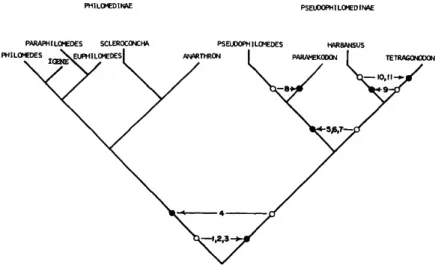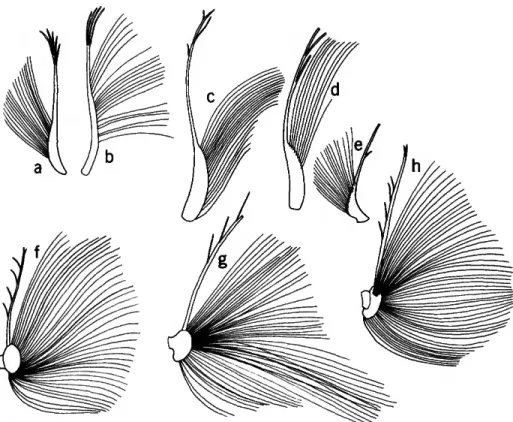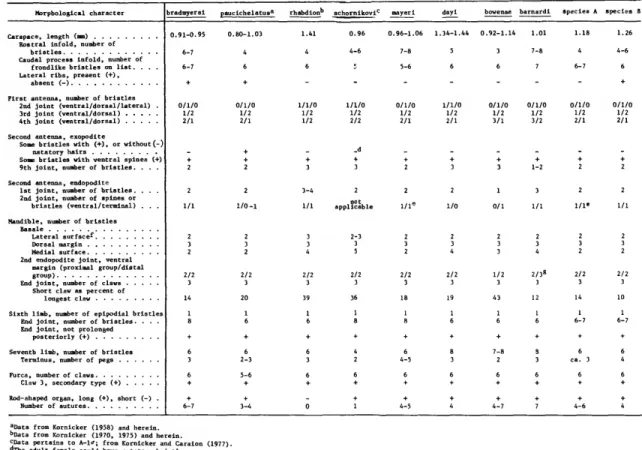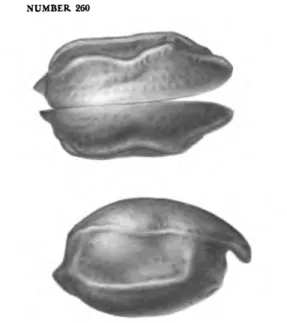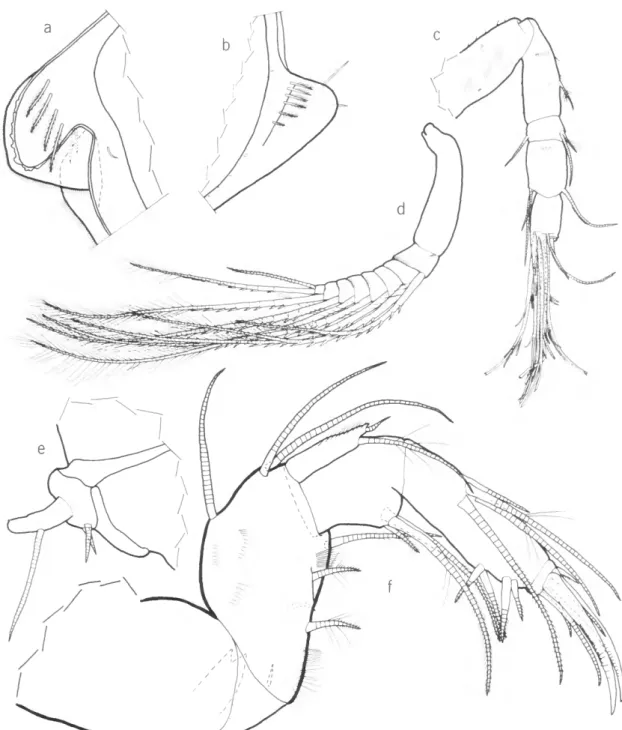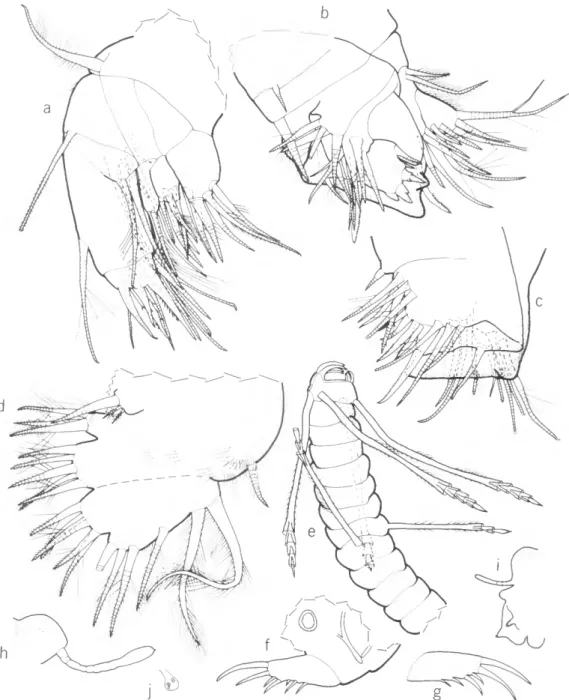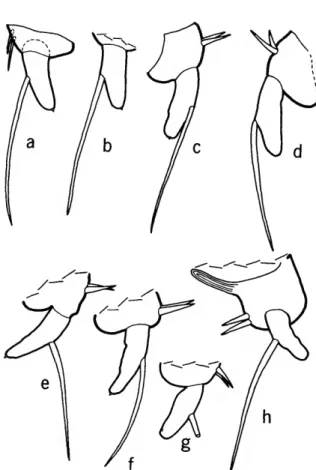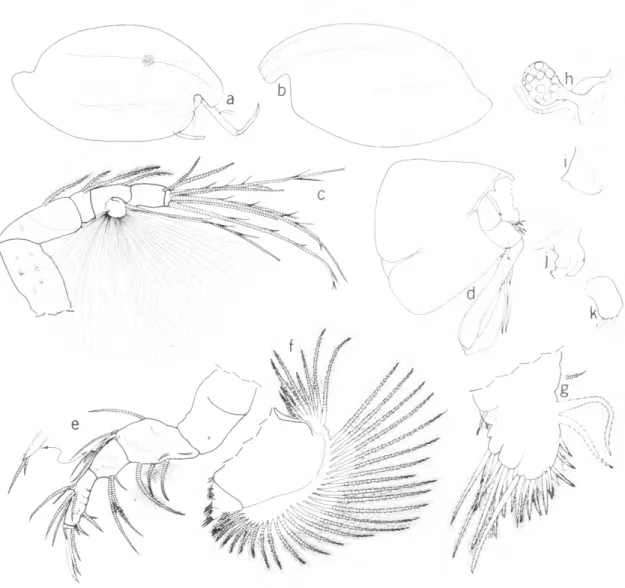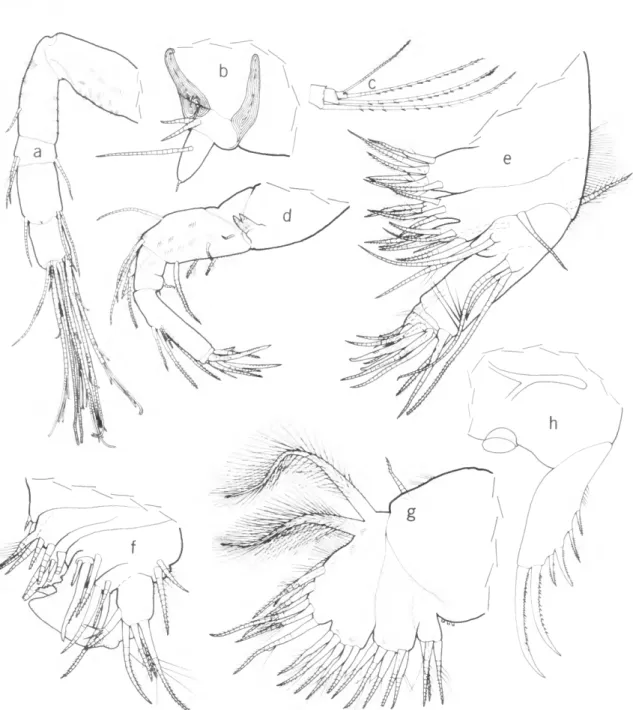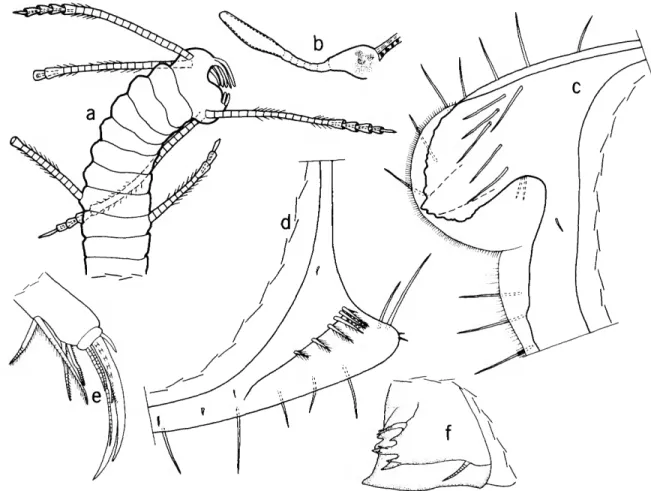Harbansus, a New Genus of
Marine Ostracoda, and a Revision of the Philomedidae (Myodocopina
LOUIS S. KORNIGKER
SMITHSONIAN CONTRIBUTIONS TO ZOOLOGY • NUMBER 260
Emphasis upon publication as a means of "diffusing knowledge" was expressed by the first Secretary of the Smithsonian. In his formal plan for the Institution, Joseph Henry outlined a program that included the following statement: "It is proposed to publish a series of reports, giving an account of the new discoveries in science, and of the changes made from year to year in all branches of knowledge." This theme of basic research has been adhered to through the years by thousands of titles issued in series publications under the Smithsonian imprint, commencing with Smithsonian Contributions to Knowledge in 1848 and continuing with the following active series:
Smithsonian Contributions to Anthropology Smithsonian Contributions to Astrophysics
Smithsonian Contributions to Botany Smithsonian Contributions to the Earth Sciences
Smithsonian Contributions to Paleobiology Smithsonian Contributions to Zoo/ogy Smithsonian Studies in Air and Space Smithsonian Studies in History and Technology
In these series, the Institution publishes small papers and full-scale monographs that report the research and collections of its various museums and bureaux or of professional colleagues in the world cf science and scholarship. The publications are distributed by mailing lists to libraries, universities, and similar institutions throughout the world.
Papers or monographs submitted for series publication are received by the Smithsonian Institution Press, subject to its own review for format and style, only through departments of the various Smithsonian museums or bureaux, where the manuscripts are given substantive review. Press requirements for manuscript and art preparation are outlined on the inside back cover.
S. Dillon Ripley Secretary
Smithsonian Institution
Harbansus, 2L New Genus of Marine Ostracoda, and a Revision of the Philomedidae (Myodocopina)
Louis S. Komicker
I S S U E D JUN-51978
SMITHSONIAN PUBLICATIONS
SMITHSONIAN INSTITUTION PRESS City of Washington
1978
Kornicker, Louis S. Harbansus, a New Genus of Marine Ostracoda, and a Re- vision of the Philomedidae (Myodocopina). Smithsonian Contributions to Zoology, number 260, 75 pages, 37 figures, 1G plates, 2 tables, 1978.—A new genus of myodocopid ostracodes in the subfamily Pseudophilomedinae is proposed to include 8 species, of which 5 are new, and 2 additional taxa in open nomenclature. Known species live along the western coast of Africa, the western coasts of North and South America, the eastern coast of Central and North America, in the Gulf of Mexico, the Bahamas, and Hawaii. The family Philomedidae is revised.
OFFICIAL PUBLICATION DATE is handstamped in a limited number of initial copies and is recorded in the Institution's annual report, Smithsonian Year. SERIES COVER DESIGN: The coral Montastrea cavernosa (Linnaeus).
Library of Congress Cataloging in Publication Data Kornicker, Louis S. 1919-
Harbansus, a new genus of marine Ostracoda, and a revision of the Philomedidae (Myodocopina).
(Smithsonian contributions to zoology ; no. 260) Bibliography: p.
1. Harbansus. 2. Streptoleberis. 3. Philomedidae. 4. Crustacea—Classification. I. Title. II.
Series: Smithsonian Institution. Smithsonian contributions to zoology ; no. 260.
QL1.S54 no. 260 [QL444.085] 591'.08s [595'.33] 77-13384
Page
Introduction 1 Station Data 2 Phylogeny and Classification 5 Character Analysis 6 Dichotomy 6 Subfamilial Dichotomy 6 Generic Dichotomy in the Subfamily Pseudophilomedinae 8 Convergence 9 Phylogeny and Zoogeography of Harbansus 10 Functional Morphology of Harbansus 11 PHILOMEDIDAE Muller, 1908 11 Key to the Subfamilies of Philomedidae 12 PHILOMEDINAE Muller, 1908 12 Key to the Genera of Philomedinae 13 PSEUDOPHILOMEDINAE Kornicker, 1967 13 Key to the Genera of Pseudophilomedinae 13 Harbansus, new genus 13 Key to the Species of Harbansus 16 Harbansus paucichelatus (Kornicker, 1958), new combination 16 Harbansus rhabdion (Kornicker, 1970), new combination 23 Harbansus schornikovi (Kornicker and Caraion, 1977), new combi-
nation 23 Harbansus bradmyersi, new species 24 Harbansus mayeri, new species 28 Harbansus dayi, new species 32 Harbansus bowenae, new species 39 Harbansus barnardi, new species 45 Harbansus species A 49 Harbansus species B 49 Harbansus species indeterminate 50 Streptoleberis Brady, 1890 51 Streptoleberis crenulata Brady, 1890 51 Streptoleberis favosa Brady and Norman, 1896 55 Streptoleberis rectirostris Brady and Norman, 1896 57 Literature Cited 58 Plates 60
Marine Ostracoda, and a Revision of the Philomedidae (Myodocopina)
Louis S. Kornicker
Introduction
The new genus Harbansus is proposed to include 8 species, of which 5 are new, and 2 additional taxa in open nomenclature: H. paucichelatus (Kornicker, 1958), H. rhabdion (Kornicker, 1970), H. schornikovi (Kornicker and Caraion, 1977), H. bradmyersi, new species, H. mayeri, new species, H. dayi, new species, H. bowenae, new species, H. barnardi, new species, H. species A, and H. species B.
Known species of the genus live along the western coast of Africa, the western coast of North and South America, the eastern coast of Central and North America, in the Gulf of Mexico, the Ba- hamas, and Hawaii (Figure 1).
Also treated herein are 3 species of Streptoleberis, a genus that resembles Harbansus, but because it is poorly known was correctly referred to "Cypri- dinidarum genera dubia and species dubiae" by Miiller (1912:51,52).
The Philomedidae is revised using the phylo- genetic principles proposed by Hennig (1966) to arrive at a classification having genera more equally distributed among the 2 existing subfamilies than in the previous classification. An attempt is made to explain the distribution of species of Harbansus
Louis S. Kornicker, Department of Invertebrate Zoology, National Museum of Natural History, Smithsonian Institu- tion, Washington, D.C. 20560.
using principles of Hennig (1966) and Croizat (1958, 1964).
ACKNOWLEDGMENTS.—I thank the following for specimens of Harbansus and Streptoleberis: Dr. Al- bert G. Long and Dr. Anthony Tynan, The Han- cock Museum, Scotland; Mr. David L. Mayer, Fish- eries Research Institute, University of Washington;
Mr. Brad Myers, Southern California Coastal Water Research Project; Dr. M. Bacescu, Museum of Natural History "Grigore Antipa," Bucharest, Ro- mania; Ms. Marcia Bowen, Virginia Institute of Marine Science; Dr. John H. Day, Beaufort Marine Laboratory, Duke University; Mrs. Anne Cohen, Dr. Roger F. Cressey, Jr., Dr. F. M. Bayer, and Dr.
J. Laurens Barnard, Smithsonian Institution, and David Gettleson, Texas A&M University. Some specimens were collected as part of the benthic macrofaunal project of the southern California base- line studies and analyses, funded by the U.S. Bureau of Land Management. I also thank Mr. Walter R.
Brown and Miss Mary J. Mann, Smithsonian Insti- tution, who operated the scanning electron micro- scope. Freeze-drying of specimens for photography was done in the laboratory of Mr. Roland Hower, Smithsonian Institution. Most initial drawings of appendages were made by Mr. Paul Mazer, who also inked the final drawings. I especially thank Mrs. Carolyn Bartlett Gast for the shaded render- ings of carapaces; Mrs. Anne Cohen, Mr. Brad
_eo
• H. pauoiohelatus A H. rhabdion if H. sahormikovi
A H. bradmyersi
• H. mayevi
•& H. dayi 4c. H. bouenae D H. barmapdi
• H. speaies A O H. speaies B
•O H. speaies indet
160 )20 80 40
FICURE 1.—Locality map of species of Harbansus.
Myers, and Dr. Thomas E. Bowman for reviewing all or parts of the manuscript; Miss Maura Me- Manus for assisting in its preparation; Dr. W.
Ronald Heyer and Dr. Donald R. Whitehead, Smithsonian Institution, for assistance in the Hen- nigian analysis, and Dr. Gareth Nelson, American Museum of Natural History, for correspondence concerning the biogeographical principles of Dr.
Croizat.
This paper is contribution number 34 of the Smithsonian Institution Investigations of Marine Shallow-Water Ecosystems Project (IMSWE).
DISPOSITION OF SPECIMENS.—Most of the speci- mens have been deposited at the National Museum of Natural History, Smithsonian Institution under the catalog numbers of the former United States National Museum (USNM). The disposition of
other specimens is given in the text in the appropri- ate section where the species is described.
Station Data
BELIZE
Carrie Bow Cay, 16°48'N, 88°05'W, part of the Smithsonian Coral Reef project (IMSWE);
small aquarium net scraping surface of sand;
1976; collector: Anne C. Cohen
Sta 16, Transect I, depth 1.5 m; sand and rubble zone of lagoon, sandy with some patches of Thalassia, staghorn coral, coral rubble, water and sediment temperature 28°C; 12 May 1976.
Harbansus paucichelatus: 11 specimens including 1 adult male.
Sta 20, 300-400 m S34°W from Carrie Bow Cay, bottom depth 9.1 m; sand with some silt and Thalassia patches adjacent to patch reef, water temperature about 28°C;
14 May 1976.
Harbansus paucichelatus: 1 specimen.
Sta 24, adjacent to Transect I, depth 24 m; sand trough of outer fore-reef, water temperature 28°C; 15 May 1976.
Harbansus paucichelatus: 1 specimen.
Sta 47, adjacent to Transect I, near bottom on inner reel slope just above sand trough, bottom depth 24 m; sand patch surrounded by coral on slope, water temperature about 28°C; 21 May 1976.
Harbansus paucichelatus: 2 specimens including 1 adult male.
Sta 62 (same locality as sta 24); 24 May 1976.
Harbansus paucichelatus: 1 ovigerous female.
Twin Cays (larger island), 16°48'N, 88°06'W; small aquarium net scraping surface of sand; 1976;
collector: Anne C. Cohen
Sta 9, sheltered inlet surrounded by mangroves on W side of island, depth 15 cm; bottom of silty sand and decay- ing vegetation, water temperature above 28°C; 10 May 1976.
Harbansus paucichelatus: 1 specimen.
CALIFORNIA
Continental shelf off Oxnard; 1973-1974; collector:
Brad L. Myers
Sta A-2, 18.3 m; Mar 1974.
Harbansus bradmyersi: 1 ovigerous female.
Sta C-2, 18.3 m; Dec 1973.
Harbansus bradmyersi: 2 adult females.
Sta C-2c, 18.3 m; Sep 1974.
Harbansus bradmyersi: 1 ovigerous female.
Sta C-3, 27.4 m; Mar 1974.
Harbansus bradmyersi: 1 adult female.
Sta OC-3, 27.4 m; Mar 1974.
Harbansus bradmyersi: 1 ovigerous female, 1 adult female.
Sta OC-3a, 27.4 m; Sep 1974.
Harbansus bradmyersi: 2 ovigerous females.
Sta OC-3b, 27.4 m; Sep 1974.
Harbansus bradmyersi: 5 ovigerous females, 1 adult fe- male without eggs, 1 juvenile or adult female without eggs-
Off Laguna Beach, Orange County; from rock scrapings; 1974; collector: Brad L. Myers
Sta K-l, 12.5 m; Mar 1974.
Harbansus bradmyersi: 1 ovigerous female.
Off Santa Catalina Island, under reef canopy, 10.7 m;
rock scraping; 1974; collector: Brad L. Myers
Harbansus bradmyersi: 1 adult female without eggs.
Offshore islands, R/V Velero 111, collected under
contract for Bureau of Land Management as a baseline presurvey for leasing oil drilling sites;
1975-1976; from collection of Allan Hancock Foundation, specimens received from Brad L.
Myers
Sta 23086 BFI, Santa Rosa Island, 33°40'N, 119°58'W, 140 m.
Harbansus species B: 1 ovigerous female.
Sta 24075 BFI, off W end of Santa Catalina Island, 33°29/
24"N, 118°44'12"W, 414 m.
Harbansus species indeterminate: 1 adult female.
FLORIDA
Anclote Anchorage, off Tarpon Springs, N of Tampa; shallow water grab sample (15 X 15 cm); 1976; collector: Dr. Patsy A. McLaughlin
Sta 30, 2.23 m; 6 Apr 1976.
Harbansus paucichelatus: 1 adult male.
Biscayne Bay, Norris Cut, off N end of Virginia Key, opposite Fisher Island, water depth about 20 cm; tidal flat with Diplanthera; sample ob- tained with small net drawn through sediment in few centimeters of water; 17 Feb 1976; col- lector: F. M. Bayer
Harbansus paucichelatus: 1 specimen.
Placida Harbor (part of Charlotte Harbor), off Bird Key; 1974; collector: Roger F. Cressey
Sample 3, 2-3m; Ockelman dredge tied to Otter trawl, mud washings; 1 May 1974.
Harbansus paucichelatus: 3 ovigerous females and 27 additional specimens.
Sample 4, 2-3 m; mud bottom; weed washings from Otter trawl; 2 May 1974.
Harbansus paucichelatus: 1 ovigerous female.
Sample 5, 1-2 m; mud washings from Ockelman dredge tied to Otter trawl; 16 Jul 1974.
Harbansus paucichelatus: 3 specimens including 1 ovi- gerous female.
Virginia Key, NE shore facing Bear Cut, water depth about 20 cm; tidal flat with rocks, green algae, Caulerpa, Padina; sample obtained with small net drawn through sediment between rock; 17 Feb 1976; collector: F. M. Bayer
Harbansus paucichelatus: 1 ovigerous female, 1 juvenile.
H A W A I I
Sta JLB Hawaii 10, Sampan Pass, Kaneohe Bay, Oahu, 2 m; heads of Pocillopora meandrina;
23 Feb 1967; recovered by divers Kruschwitz
and Bowers (see Barnard, 1970:277 for amphi- pods of 23 species collected at station)
Harbansus barnardi: 1 ovigerous female; 1 A-l male.
MEXICO
Guadalupe Island, 1.6 mi and 60°T (true) from South Bluff, R/V Velero III; sand bottom;
dredge; from collection of Allan Hancock Foundation, specimen received from Brad L.
Myers
Sta 1927, 73.2-102.4 m; 20 Dec 1949.
Harbansus species A: 1 ovigerous female.
NEW JERSEY
Outer continental shelf, research vessel Columbus Iselin; 0.10 square meter Maclntyre grab sampler; Nov 1975; collector: Marcia Bowen, Virginia Institute of Marine Science
Sta A3-8, 39°16'37"N, 72°29'57"W, 136 m.
Harbansus dayi: 1 adult male and 2 juveniles.
Sta A4-9, 39°14'17"N, 72°26'43"W, 196 m.
Harbansus dayi: 7 specimens including 1 adult female and juveniles.
Harbansus bowenae: 3 juveniles plus 1 2nd antenna of adult female.
Sta A4-11, 39°14'17"N, 72°26'43"W, 1% m.
Harbansus dayi: 12 specimens including adult females and juveniles.
Harbansus bowenae: 18 specimens including adult fe- males and juveniles.
Sta A4-12, 39°14'17"N, 72°26'43"W, 196 m.
Harbansus dayi: 2 juvenile females.
Sta F4-7, 39°44'36"N, 73°O3'O4"W, 183 m.
Harbansus dayi: 11 specimens including ovigerous fe- males and juveniles.
Harbansus boivenae: 47 specimens including ovigerous females and juveniles.
Sta F4-10, 39°44'36"N, 73°03'04"AV, 183 m.
Harbansus dayi: 1 adult male.
NORTH CAROLINA
Beaufort Shelf Transect; 1964-1965; collector: John H. Day
Sta 55 P, 34°19'30"N, 75°56'18"W, 160 m; sandy mud, sedi- ment temperature 22°C; 0.2 square meter Van Veen Grab; 6 Apr 1964.
Harbansus dayi: 1 adult female.
Sta 155 G, 34°00'00/'N, 75°53'42"W, 160 m; sandy mud, sediment temperature 19.5°C; 0.2 square meter Van Veen Grab; 30 Sep 1965.
Harbansus dayi: 1 adult female.
Sta 251 N-P, 34°23'18"N, 75°54'12"W, 160 m; sediment median grain size 0.250 mm, sediment temperature 16.5°C; 0.2 square meter Van Veen Grab; 30 Nov 1965.
Harbansus dayi: 1 adult female.
Sta 253 M, 34°22'48"N, 75°51'48"W, 190 m; sediment me- dian grain size 0.166 mm (mud), sediment temperature 12.7°C; dredge for 10 minutes; 30 Nov 1965.
Harbansus dayi: 1 ovigerous female.
Sta 256 Q-R, 34°22'48"N, 75O51'24"W, 198 m; sediment me- dian grain size 0.166 mm, sediment temperature 12.7°C;
0.2 square meter Van Veen Grab; 30 Nov 1965.
Harbansus dayi: 1 adult female.
PERU
Peru-Chile trench, 08°23'S, 80°45'W, 3086-3202 m, R/V Anton Bruun, cruise 11; benthic trawl sample; 18 Oct 1965; collector: M. BScescu, Museum of Natural History, "Grigore Antipa,"
Bucharest, Romania.
Harbansus rhabdion: 1 ovigerous female.
TEXAS
Gulf of Mexico, off Galveston, R/V Gyre (Texas A&M University); 1974; collector: David Gettle-
Cruise 10.
Sta 8, 25°10'N, 94°18'W, 56 m.
Harbansus paucichelatus: 5 specimens.
Sta 16, 25°10'N, 94°18'W. 53.5 m.
Harbansus paucichelatus: 2 specimens.
Cruise 11.
Sta 1, 28°24'N, 93°57'30"W, 49.25 m.
Harbansus paucichelatus: 3 specimens.
Sta 2, 28°22'36"N, 94°01'30"W, 49.75 m.
Harbansus paucichelatus: 6 specimens.
Sta 5, 28°19'30"N, 94°09'00"W, 50 m.
Harbansus paucichelatus: 4 specimens.
Sta 7, 28°16'N, 94°06'30"W, 53 m.
Harbansus paucichelatus: 17 specimens.
Sta 8, 28°15'18"N, 94°03'00"W, 57.75 m.
Harbansus paucichelatus: 5 specimens.
Sta 9, 28°2rO6"N, 93°40'18"W, 57.5 m.
Harbansus paucichelatus: 13 specimens.
Sta 11, 28°22'12"N, 93°49'30"W, 54.75 m.
Harbansus paucichelatus: 13 specimens.
Sta 12, 28°23'3O"N, 93°53'30"W, 51-75 m.
Harbansus paucichelatus: 8 specimens.
Gulf of Mexico, Heald Bank, 40 mi SW of Sabine Pass, Magnolia cruise 15, depth about 15 m;
18 Oct 1953; collector: W. G. Hewatt
Harbansus paucichelatus: 1 ovigerous female.
WASHINGTON
North side of Kiket Island, Similk Bay, 48°25'10"N, 122°35'50"W, water depth 8 m; soft mud bot- tom, salinity range 21.07-29.75 parts per thou- sand, temperature range 5.9°-14.1°C, tidal range 4.9 m; diver operated core sampler, 2.21 cm diameter, material sieved through 0.495 mm Tyler standard sieve; 1972; collector: David Mayer
Harbansus mayeri: 8 specimens including 3 ovigerous fe- males, 3 adult females, and 2 juveniles.
Phylogeny and Classification
Philomedidae Miiller, 1908, consists of 2 sub- families: Philomedinae Miiller, 1908, and Pseudo- philomedinae Kornicker, 1967b. Kornicker (1968:
449) recognized only 2 genera in Pseudophilo- medinae: Pseudophilomedes Miiller, 1893, and Paramekodon Brady and Norman, 1896. At that time, adult males were unknown for both genera.
Adult males remain unknown for Paramekodon, but they have been described for 2 species of Pseudophilomedes by Kornicker and Caraion (1977).
Some of the morphological characters of the adult males of Pseudophilomedes suggest that the genus might be closely related to the genus Telragonodon Brady and Norman, 1896, a genus that had been assigned to Philomedinae by Kornicker (1968:449), and also closely related to the new genus Harbansus proposed herein.
Because of this, it was decided to investigate the phylogeny of Philomedidae using the principles proposed by Hennig (1966) in which derived (apo- morphic) rather than primitive (plesiomorphic) character states are considered important for group- ing taxa. This method was used for reconstructing a phylogeny of superfamilial and higher categories of Ostracoda by Kornicker and Sohn (1976).
One of the difficulties in making a Hennigian analysis is determining directionality, i.e., which condition of a character is plesiomorphic and which is apomorphic. Another difficulty is deciding which of many reconstructed phylogenies is more likely to approximate the actual phylogeny. If a satis- factory phylogeny is derived from the analysis, it is then necessary to decide to what degree it should be used to form the basis of a classification. Perhaps the greatest advantage of this method for recon-
structing a phylogeny, and ultimately for develop ing a classification, is that each step in the deriva- tion is clearly defined, and thus open to future revision in an objective manner.
The objective of the present analysis was to deter- mine whether or not Philomedidae should be split into smaller groupings (subfamilies) and, if so, which genera should be included in each group.
First to be considered was the present division of the family into 2 subfamilies: Pseudophilomedinae with 2 genera, and Philomedinae with the remain- ing genera. With that division it was possible to assign 2 synapomorphic character states (shared de- rived) to Pseudophilomedinae, but none to Philo- medinae. The 2 apomorphic characters states used were those upon which Pseudophilomedinae was based (Kornicker 1968:448, 449): a small 3rd endite on the maxilla and a saber-like tooth on the 2nd exopodial joint of the 5th limb. Those character states are found in no other myodocopids. Clearly, a phylogeny in which more synapomorphic char- acter states are present in the divisions would be preferable to the present division.
The reconstructed phylogeny finally arrived at is one in which Pseudophilomedinae contains 3 syn- apomorphic character states, and Philomedinae con- tains 1 synapomorphic character state. In the pro- posed phylogeny, Pseudophilomedinae contains the genera Pseudophilomedes, Paramekodon, Tetrago- nodon, and Harbansus, and the remaining 6 genera are retained in Philomedinae (Figure 2). The 4 morphological characters used in the analysis are discussed below. A total of 4 character states is an insufficient number to arrive at more than a very tenuous phylogeny; additional information is needed to confirm the proposed phylogeny.
An attempt was made to derive the phylogeny of the genera in the subfamily Pseudophilomedinae, but because of the inability to justify a decision as to whether some of the character states are apomor- phic or plesiomorphic, the results were unsatisfac- tory. The directionality of character states are indi- cated in Figure 2 more as a guide showing available data rather than as support for the proposed phy- logeny. The proposed phylogeny in Figure 2 for the subfamily Philomedinae is based on overall similar- ities and differences because of the inability to jus- tify directionality of character states.
Cypridinacea contains 5 families: Cypridinidae, Philomedidae, Sarsiellidae, Rutidermatidae, and
PHILOMEOINAE PSEUDOPHILOMEDIMAE
PARAPH ILOMEDES SCLEROCONCHA PSEUDOPHILOMEDES HARBANSUS
ANARTHRON | PARAMEKOOON | TETRAGONOOON
FIGURE 2.—Reconstructed phylogcny of the Philomedidae (open circle = plcsiomorphic character state; closed circle
— apomorphic character state; numbers correspond to char- acters listed in text under "Character Analysis").
Cylindroleberididae. Of these, only the members of Cypridinidae are known as Paleozoic fossils. Because fossils of that family are fairly abundant in the Paleozoic, it seems likely that if members of other families were living at that time, some of them would also have been preserved. Therefore, an assumption is made herein that some character states present on recent Cypridinidae are probably plesiomorphic. Because evolutionary rates are un- known in the families, this criterion for determin- ing the directionality of character states must be used with caution, which I have attempted to do.
Another method used for estimating direc- tionality of character states is the distribution of the character states among the various taxa. In general, character states widespread in taxa other than the sister groups being evaluated are con- sidered plesiomorphic.
Character Analysis
DICHOTOMY
Subfamilial Dichotomy
1. Sensory bristle of the 5th joint of the male 1st antenna: In the Cypridinidae the sensory bristle of the male is similar to that of the female or bears a few additional filaments. In some genera
(Bathyvargula, Metavargula) some of the filaments are much wider than those of the female, but usu- ally the filaments are slender on both sexes, or only slightly wider on the male. In the Philomedidae and in other families of the Cypridinacea, the sen- sory bristle of the male bears many more filaments than are present on the female. Because of the antiquity of the Cypridinidae, the sensory bristle of the male Cypridinidae is considered here to be a primitive type.
The genera of the Philomedidae exhibiting the male sensory bristle character may roughly be di- vided into 2 types (see Figure 3), depending on the state of this character: type 1, long filaments con- centrated along an elongate widened segment occu- pying the proximal one-third to two-thirds of the bristle; type 2, long filaments concentrated on a bulbous segment occupying about the proximal one-fifth of the bristle (the proximal edge of the bulb projects backward). The sensory bristle of the male Parapliilomed.es (see Poulsen, 1962:403, fig.
176e') appears to be transitional between character states 1 and 2 in having the long filaments concen- trated near the proximal end of the bristle (Fig- ure ?>e). It is, however, assigned to type 1 because the proximal part containing the filaments does not project backward as does the bulbous part of the type 2 bristle.
FIGURE 3.—Sensory bristle of 1st antennae of adult males of selected genera of the subfamilies Philomedinae (a-e) and Pseudophilomedinae (J-h): a, Euphilomedes agilis (Thomson, 1879); b, Philomedes heptathrix Kornicker, 1975; c, Scleroconcha arcuata Poulsen, 1962; d, Igene walleni Kornicker, 1975; e, Paraphilomedes unicornuta Poulsen, 1962 (adapted from Poulsen, 1962:403, fig. 176e/); /, Harbansus dayi, new species; g, Tetragonodon ctenorhynchus (Brady, 1887); h, Pseudophilomedes thalassa Kornicker and Caraion, 1977. (Tips of stems broken in d,eg.)
Because the type 1 bristle appears to be inter- mediate between the sensory bristle of the male Cypridinidae and the type 2 bristle, it is considered here to be plesiomorphic, and genera having the type 2 bristle to be synapomorphic. The type 2 sen- sory bristle is also present on males of the Sarsielli- dae. I consider this to be convergence. The male sensory bristle of other families (Cylindroleberididae, Rutidermatidae) more closely resembles the type 1 bristle. The adult male of the genus Paramekodon is unknown but I assume it to be similar to that of the closely related genus Pseudophilomedes.
2. Bristles on list of infold of caudal process: In the Philomedidae the bristles consist of 2 types:
type 1, small, slender, bare bristles; type 2, broad, spinous, frondlike bristles. I consider the latter type,
which is found elsewhere only in some of the Sarsiel- lidae, to be the apomorphic character state, and those genera having the type 2 bristles to be syna- pomorphic. An exception to the two types is seen in the bristles on the caudal process of Euphilo- medes ferox Poulsen, 1962 (Poulsen, 1962:392, fig.
nib), which bears slender bristles branching dis- tally. These bristles may be intermediate between types 1 and 2, but I consider them as a variation of type 1 bristles.
3. End joint of the 6th limb: The 6th limbs of the Cypridinidae, Philomedidae, Sarsiellidae, and Rutidermatidae are more or less similarly con- structed, whereas the 6th limb of the Cylindro- leberididae is considerably different. The end joints of the 6th limbs of the first 4 families are of 2 types:
type 1, end joint with considerable posterior projec- tion; type 2, relatively slight posterior projection.
The type 1 end joint is present on all of the Cypridinidae and on some of the Philomedidae;
whereas the type 2 end joint is present on the re- mainder of the Philomedidae and on the Sarsiellidae and Rutidermatidae. Because of the antiquity of the Cypridinidae, I consider the type 1 end joint to be the plesiomorphic character state. The presence of the type 2 end joint in many divergent groups is interpreted to be due to convergence. With the exception of Igene walleni and a few species of Euphilomed.es, those genera in the Philomedidae having the type 2 end joint are considered to be synapomorphic. Igene walleni and the few species of Euphilomedes having the type 2 end joint are considered to be convergent.
4. Relative lengths of the 2nd and 3rd joints of the exopodite of the male 2nd antenna: In the Cypridinidae and the Sarsiellidae the exopodites of males and females are similar in having the 2nd joints slightly longer than the 3rd joints. In the Cylindroleberididae, the exopodites of the males and females are similar, or the males have a much longer 2nd joint than present on the females. The exopo- dite of the male Philomedidae may be divided into 2 types: type 1, similar to that of female; type 2, 3rd joint much longer than 2nd. The type 1 exopo- dite of the male is considered here to be the plesio- morphic character state, and genera having the type 2 exopodite to be synapomorphic. Males of the Rutidermatidae also have the type 2 exopodite. I consider this to be convergence.
Generic Dichotomy in the Subfamily Pseudophilomedinae
5. Large tooth of 2nd exopodial joint of the 5th limb of the female: In the Pseudophilomedinae this tooth may be divided into 2 types: type 1, tooth squarish in shape: type 2, tooth with saberlike pro- longation. The type 1 tooth is also present in members of the Philomedinae and Rutidermatidae, and is considered here to be the plesiomorphic char- acter state. Genera with the type 2 tooth are con- sidered synapomorphic. The teeth on Euphilomedes ferox Poulsen. 1962, and Euphilomedes agilis (Thom- son, 1879) appear to be intermediate types and are here assigned to type 1.
6. Endite III of the maxilla: In the Pseudo- philomedinae this endite may be divided into 2 types: type 1, endite well developed; type 2, endite very small. The type 1 endite is present also on members of the Cypridinidae and Philomedinae and is considered here to be the plesiomorphic char- acter state. The type 2 endite is present only in the Pseudophilomedinae. Genera with the type 2 endite are considered synapomorphic.
7. Exopodite of the maxilla: In the Pseudo- philomedinae the exopodite consists of 2 types: type 1, exopodite consisting of lobe with 3 bristles near ventral margin of basale; type 2, exopodite consist- ing of 3 bristles near dorsal margin of basale, lobe absent. (It is possible that the type 2 exopodite is not really an exopodite but merely 3 bristles on the basale. In that interpretation the type 2 endite considered above in item 6 would be considered the exopodite, and the Pseudophilomedinae would have only 2 endites; this interpretation would not change the proposed phylogeny or classification.) The type 1 exopodite is present also on the Cypridinidae and Rutidermatidae and is considered herein to be the plesiomorphic character state. Genera with the type 2 character state are synapomorphic.
8. Bristles on the 7th joint of the female 1st antenna: Among the Philomedidae, the b-bristle is absent only on members of Paramekodon. The absence of the bristle is considered here to be the apomorphic character state.
9. Number of furcal claws: Members of the genus Harbansus have only 5 or 6 furcal claws.
Most members of the Cypridinidae and Philome- didae have more than 6 claws. Therefore, the pres- ence of fewer claws on the furca of Harbansus than on the sister group Tetragonodon, which has many furcal claws, is considered here to be apomorphy.
However, species with 6 furcal claws are also pres- ent in the out groups Euphilomedes and Pseudo- philomedes. These are considered here to be cases of convergence, but they are sufficiently numerous to make the directionality of this character ques- tionable.
10. Rod-shaped organ: This organ is absent only on members of the genus Tetragonodon.
Therefore, this character state (absence) is consid- ered to be apomorphic.
11. Medial eye: The organ is absent only on members of the genus Tetragonodon. This absence is considered the apomorphic character state.
CONVERGENCE
In reconstructing a most parsimoniuus phylogeny using the principles of Hennig, it is not uncommon to find seemingly apomorphic character states in some members of different lineages. These are as- sumed here to be the result of convergence, but no attempt has been made to discriminate between con- vergence and parallelism. The reconstructed phy- logeny is that which contains fewest convergences.
These are summarized below. The same numbers are used as those listed under "Dichotomy." No convergences occurred in states 4, 6-8, or 11.
1. Sensory bristle of the 5th joint of the male 1st antenna: The genus Paraphilomedes Poulsen, 1962, is known from 2 species, of which the adult male is known for only Paraphilomedes unicornuta Poulsen, 1962. The base of the sensory bristle of the 1st antenna of the adult male of that species is much broader than that of other members of the Philomedinae as revised herein (Figure 3e). It may be an intermediate form between the typical plesio- morphic type 1 and apomorphic type 2 character states of the sensory bristle. As an intermediate form it could belong in the branch containing the Pseu- dophilomedinae, rather than in the branch contain- ing the Philomedinae as proposed herein. However, Paraphilomedes is referred to the Philomedinae because it has the apomorphic type 2 exopodite of the male 2nd antenna (character state 4), also re- ferral of Paraphilomedes to the Pseudophilomedinae would result in convergences in characters 2 and 3.
The type 2 character state, considered here to be synapomorphic among the Pseudophilomedinae, is also characteristic of the family Sarsiellidae. This is considered to be convergence because the Sarsiel- lidae and Pseudophilomedinae differ from one an- other in many of other apomorphic character states.
This observation lends support to the suggested con- vergence between Paraphilomedes and Pseudo- philomedinae.
If the type 2 character state should prove to be plesiomorphic rather than apomorphic, the pro- posed reconstructed phylogeny would remain un- changed, but the character state would serve to show a close relationship among the Philomedinae rather than among the Pseudophilomedinae.
2. Bristles on list of infold of caudal process:
Euphilomcdcs ferox Poulsen, 1962, bears setose bristles that could be considered intermediate be-
tween the simple plesiomorphic type 1 bristles of the Philomedinae and the setose apomorphic type 2 bristles of the Pseudophilomedinae. Adult males of E. ferox are not known; however, I assume them to have the apomorphic type 2 exopodite of the 2nd antenna (character state 4) of the adult male of the presumably closely related E. agilis (Thomson, 1879) and of other Philomedinae. For this reason I con- sider E. ferox to be a member of the Philomedinae.
However, it should be mentioned that the female 5th limb of both E. ferox and E. agilis resembles that of species of Pseudophilomedes and Para- mekodon, both members of the Pseudophilomedinae.
This is discussed further under character state 5 below wherein additional reasons are given for assuming convergence. Setose bristles on some mem- bers of the Sarsiellidae are also considered con- vergent.
3. End joint of the 6th limb: Although the type 2 end joint, considered herein to be synapomorphic among the Pseudophilomedinae, is also present on the Sarsiellidae and Rutidermatidae, I consider this to be convergence because those families differ con- siderably in other apomorphic characters.
Igene walleni Kornicker, 1975, Euphilomedes multichelatus (Kornicker, 1958), E. arostratus Kor- nicker, 1967a, E. polae (Graf, 1931), and probably E. fonsecensis (Hartmann, 1959) and E. oblongus (Juday, 1907) have the type 2 end joint of the 6th limb, which is synapomorphic among the Pseudo- philomedinae. The type 2 end joints of the above 6 species of Euphilomedes are considered to be con- vergent, because these species have the apomorphic type 2 exopodite of the male 2nd antennae indicat- ing that they belong in the Philomedinae. Also, referral of these species to Pseudophilomedinae would result in convergences in character states 1 and 2.
5. Large tooth of the 2nd exopodial joint of the 5th limb of the female: As mentioned under character state 2 above, the teeth on the exopodite of the 5th limb of Euphilomedes ferox and E. agilis appear to be intermediate between the plesiomophic type 1 and apomorphic type 2 character states. As discussed above, the bristles on the infold of the caudal process of the carapace of E. ferox also could be intermediate between the plesiomorphic and apomorphic character states of the bristles. The similarity of the teeth on the 5th limbs of E. ferox and E. agilis to those of species of Pseudophilomedes
and Paramekodon is considered convergence be- cause the 2 species have the apomorphic type 2 exopodite of the 2nd antenna characteristic of the Philomedinae (known for E. agilis, assumed for E. ferox). These 2 species have neither the apomor- phic type 2 sensory bristle on the male 1st antenna, nor the apomorphic type 2 end joint of the 6th limb, whose presence would indicate them to be more closely related to the Pseudophilomedinae than to the Philomedinae. Thus, even if this group of Euphilomed.es is considered a basal element of the Pseudophilomedinae lineage (close to the point where the 2 subfamilies branch), characteristic 5 is not synapomorphic within the lineage and is there- fore unequivocably convergent. At present, I regard this group of Euphilomedes as at least related to, if not truly congeneric, with other Euphilomedes; if this is so, their possession of apomorphic character states 2 and 5 must be regarded as convergent with those of the Pseudophilomedinae. The question of relationships within Euphilomedes remains to be worked out.
9. Number of furcal claws: Several species of Pseudophilomedes (P. angulatus Muller, 1894, P.
foveolatus Muller, 1894, and P. tetrathrix Kornicker and Caraion, 1977) bear 6 claws on the caudal furca, a character state considered herein to be apomor- phic when comparing the genera Harbansus and Tetragonodon. Euphilomedes bradyi Poulsen, 1962, also bears only 6 furcal claws. In the family Sarsiel- lidae, members of the genera Sarsiella and A delta have only 5 furcal claws. Reduction of the number of furcal claws also occurs in the Cypridinidae.
Therefore, the reduction of furcal claws should not be used to separate higher taxa, and is of marginal use at the generic level. It is used herein as a syn- apomorphic character state in the genus Harbansus, but it would not be unexpected for new species of Harbansus to be found with more than 6 furcal claws.
10. Rod-shaped organ: The absence of a rod- shaped organ is considered the apomorphic char- acter state herein. The state is exhibited only in the genus Tetragonodon. The rod-shaped organ is small in the genus I gene Kornicker, 1975, which is referred to the Philomedinae, and also in the species Harbansus rhabdion (Kornicker, 1970), which is referred to the Pseudophilomedinae. All members of the presumably ancestral family Cypridinidae also have a small rod-shaped organ, suggesting that a
small organ is plesiomorphic. However, members of the other cypridinid families have the long organ.
Therefore, I have been unable to resolve satisfac- torily the directionality of the short and long rod- shaped organ in the Philomedidae, but I believe that the complete absence of the organ is apomor- phic. I think it possible that the small organ of the ancestral Cypidinidae evolved into a long organ in the other families, and that the organ in some mem- bers of those families later became small or was lost.
Phylogeny and Zoogeography of Harbansus I have attempted to interpret the phylogeny and zoogeography of Harbansus using the principles of Hennig (1966) and Croizat (1958, 1964; also see Croizat et al., 1974). This method was applied with notable success by Brundin (1966), Rosen (1975), and Platnick (1976) to other taxa, and has been discussed by Nelson (1969, 1974). The character states for which apomorphic and plesiomorphic conditions could be postulated with reasonable con- fidence were of insufficient number to reconstruct more than a very tenuous phylogenetic relationship for known species of Harbansus (Table 1; Figure 4).
Because Croizat's views, however, have not pre- viously, to my knowledge, been applied to Ostracoda I believe it is warranted to present the results for the purpose of stimulating examination of the method by others. The localities of the specimens are noted in Figure 4.
Assuming a widespread ancestral population, and that speciation resulted from "vicariance" (fragmen-
TABLE 1.—Plesiomorphic and apomorphic character states in species of Harbansus
edge of
5. Ungth of
margin o 7. Number of endopodi
Character state sutures In rod-shaped
rod-shaped organ . .
f 2nd endopodial j o i n t long claws in d i s t a l al Joint of mandible .
0 r g a O
to anterior
of mandible . . . . group of 2nd
Plesiomorphic 0-1 6-8
parallel
long
2
0
Apomorphic 3-7
A
oblique
short
3
1
H. tchornikovi H. rhabdion 7 North American H. bornardi Africa South America •p«ci«§ Hawaii
FIGURE 4.—Reconstructed phylogeny and geographic distri- bution of species of Harbansus (numbers correspond to char- acters listed in Table 1; for meaning of symbols see Figure 2).
tation) of that population, the reconstructed phy- legeny suggests the following series of events: (1) the first vicariant event separated the African popu- lation from the New World and Hawaiian popula- tion; (2) a second vicariant event separated the South American population from the North Amer- ican and Hawaiian population; and (3) a third vicariant event separated the North American pop- ulation from the Hawaiian population. I will not attempt to speculate on the vicariant events nor on the possible influence of migration.
Functional Morphology of Harbansus Natatory hairs are absent on the exopodial bristles of the 2nd antennae of juveniles of both sexes of all species of Harbansus, and on adult females of Harbansus, except for the adult female H. pauci- chelatus. Therefore, all except the latter are in- capable of swimming and are restricted to crawling on, and burrowing into, the sediment. The latter function is assisted by stout ventral spines on exo- podial bristles of the 2nd antenna. Although the adult male is know for only 2 species of Harbansus (H. dayi and H. paucichelatus), it seems likely that all adult males have natatory bristles on the 2nd antennae allowing them to actively seek the female by swimming. The adult male of H. paucichelatus, but not that of H dayi, has ventral spines on the exopodial bristles of the 2nd antennae suggesting that the former species may be more efficient at burrowing than the latter species.
The distal part of the natatory bristles on the adult female of some species of Philomedes and Scleroconcha, both members of the Philomedinae,
break off soon after mating so she must spend the remainder of her life on the bottom (Kornicker, 1975:76). In the present collections, the natatory bristles on several ovigerous females of H. pauci- chelatus were unbroken, but the 2nd antenna of the specimen from the Bahamas illustrated by Kor- nicker (1958: fig. 54C) has the tips of several bristles missing suggesting that the distal ends of the bristles may break off in this species also. However, it is possible that the appendage illustrated by Kornicker (1958) is not representative. An indica- tion of this is that the bristle of the 2nd joint is broken, but not that of the 3rd joint. In other species in which the bristles of the adult female are broken, the broken bristles are restricted to the distal joints.
The absence of natatory bristles on the 2nd antennae of juveniles is common in the family Philomedidae, where natatory bristles have been reported on juveniles of only 1 species (Kornicker, 1975:74). On the other hand, the absence of nata- tory bristles on adult females is uncommon, and has been reported only in the genera Tetragonodon and Igene, both known only from deep water (Kor- nicker, 1975:74). Many adult females in the family are known to rise in the water column to mate;
probably adult females of H. paucichelatus also do this, but other species of Harbansus must remain on the bottom during mating.
Members of Philomedidae are detritus feeders (collectors) (Kornicker, 1975:39). Although gut con- tent of only H. bradmyersi was examined, it is assumed all species of Harbansus are probably also detritus feeders. The inability of juveniles and adult females of most of the species to swim suggests that they feed while crawling on the bottom, or possibly, while burrowing in the sediment. The extreme reduction of the coxale endite of the man- dible and the reduced and weakly developed maxilla and 5th limb of the adult male indicate that it may not eat; therefore, the adult male prob- ably dies soon after mating.
PHILOMEDIDAE Mttller, 1908
Philomedidae contains two subfamilies: Philo- medinae Miiller, 1908, and Pseudophilomedinae Kornicker, 1967b.
DIAGNOSIS OF FEMALES AND JUVENILE MALES.—
Carapace: Lamellar prolongation of selvage with hirsute fringe.
First Antenna: 3rd and 4th joints separated by distinct suture; a-bristle of 7th joint not clawlike.
Second Antenna: Protopodite without distomedial bristle.
Mandible: Coxale endite consisting of short spin- ous process with bifurcate tip. Exopodite 40-100 per- cent of length of dorsal margin of 1st endopodial joint, usually with 2 bristles, of which 1 is as long as, or longer than, exopodite.
Maxilla: End joint usually with more than 8 bristles, some pectinate.
Fifth Limb: 2nd joint of exopodite with large tooth.
Sixth Limb: Consisting of 4 endites and large flat end joint.
Seventh Limb: Tip with single comb opposite 1 or more pegs.
Furca: All claws separated from lamella by suture.
Long hairs medial to bases of some claws and along margin of lamella following claws.
Upper Lip: Glandular field present but not easily seen except for minute processes on anterior tip.
DIAGNOSIS OF ADULT MALES.—Carapace: Lamellar prolongation of selvage with hirsute fringe.
First Antenna: 3rd and 4th joints separated by distinct suture; sensory bristle of minute 5th joint with numerous long hairs; a-bristle of 7th joint not clawlike; b- and c-bristles without suctorial discs.
Mandible: Coxale endite consisting of minute process. Exopodite similar to that of adult female.
Maxilla: Reduced; end joint usually with more than 8 bristles, none pectinate.
Fifth Limb: Exopodite reduced; 2nd joint with- out large flat tooth.
Sixth Limb: Similar to that of adult female.
Seventh Limb: Generally similar to that of female or with fewer bristles, but absent on some species of Harbansus.
Furca and Upper Lip: Similar to those of adult female.
Key to the Subfamilies of Philomedidae
ADULT MALES
Sensory bristle of the 5th joint of the 1st antenna on bulbous segment occupying about the proximal one-fifth of the bristle (the proximal edge of the bulb projecting backwards)
PSEUDOPHILOMEDINAE
Sensory bristle of the 5th joint of the 1st antenna on widened segment occupying the proximal one-third to two-thirds of the bristle (the proximal edge of the widened segment not pro- jecting backwards) PHILOMEDINAE
FEMALES AND JUVENILE MALES
1. End joint of 6th limb with considerable posterior projection PHILOMEDINAE [part]
End joint of 6th limb without considerable posterior projection 2 2. Furca with more than 6 claws PHILOMEDINAE [part]
Furca with 5 or 6 claws PSEUDOPHILOMEDINAE
PHILOMEDINAE Miiller, 1908
I recognize 6 genera in Philomedinae: Philomedes Lilljeborg, 1853, Paraphilomedes Poulsen, 1962, Euphilomedes Poulsen, 1962, Scleroconcha Skogs- berg, 1920, Anarthron Kornicker, 1975, and I gene Kornicker, 1975.
DIAGNOSIS.—Sensory bristle of 1st antenna of adult male with long filaments concentrated along
an elongate widened segment occupying the prox- imal one-third to two-thirds of the bristle (the proximal edge of the widened part not projecting backward). End joint of 6th limb with considerable posterior projection (except for Igene and some species of Euphilomedes). Third joint of expodite of 2nd antenna of adult male much longer than 2nd joint. Bristles on list of caudal infold slender, usually bare (except in Euphilomedes ferox).
Key to the Genera of Philomedinae
1. Each lamella of furca with 6 claws Euphilomedes bradyi Poulsen Each lamella of furca with more than 6 claws 2 2. Endopodite of female 2nd antenna with single joint Paraphilomedes Endopodite of female 2nd antenna with 2 joints 3 3. Carapace of female with 2 or more horizontal ribs (absent or redticed on male) 4 Carapace without horizontal ribs 5 4. Rod-shaped organ with about 15 sutures Scleroconcha Rod-shaped organ with wrinkles or few sutures Anarthron 5. Furca with secondary claws between primary claws Euphilomedes Furca without secondary claws, or secondary claws following primary claws 6 6. Rod-shaped organ rodlike, long Philomedes Rod-shaped organ conelike, short tgene
PSEUDOPHILOMEDINAE Kornicker, 1967 I recognize 4 genera in Pseudophilomedinae:
Pseudophilomedes Miiller, 1893, Paramekodon Brady and Norman, 1896, Tetragonodon Brady and Norman, 1896, and Harbansus, new genus.
DIAGNOSIS.—Sensory bristle of 1st antenna of adult male with long filaments concentrated on bulbous
segment occupying about the proximal one-fifth of the bristle (the proximal edge of the bulb projecting backwards). End joint of the 6th limb with rela- tively slight posterior projection. Third joint of exopodite of 2nd antenna of adult male slightly shorter than 2nd joint. Bristles on list of caudal infold broad, spinous, frondlike.
Key to the Genera of Pseudophilomedinae
Tooth of 2nd exopodial joint of 5th limb of adult females or juvenile males and females with saberlike prolongation 2 Tooth of 2nd exopodial joint of 5th limb of adult females or juvenile males and females without saberlike prolongation 3 7th joint of female 1st antenna with b-bristle Pseudophilomedes 7th joint of female 1st antenna without b-bristle Paramekodon Rod-shaped organ elongate Harbansus, new genus Rod-shaped organ lacking Tetragondon
Harbansus, new genus
ETYMOLOGY.—The genus is named after Harbans S. Puri, Florida Geological Survey, who has con- tributed much to the knowledge of Ostracoda.
Gender masculine.
TYPE-SPECIES.—Harbansus bradmyersi, new spe- cies.
DISTRIBUTION.—Members of the genus have been collected off the coast of Spanish Sahara at a depth of 260 m; in the Peru-Chile Trench off Peru at a depth of 991-1015 m; in the Bahamas at depths of 1-20 m; in Biscayne Bay, Florida, at subtidal depths;
in Placida Harbor, Florida, at depths of 1-3 m; in Similk Bay, Washington, at a depth of 4.9 m; off Oxnard, California, at depths of 18.3-27.4 m; off Catalina Island, California, at depths of 10.7 and
414 m; off Laguna Beach, California, at a depth of 12.5 m; on Heald Bank, Gulf of Mexico, off Texas, at a depth of about 15 m; off Beaufort, North Caro- lina, at depths of 160-198 m; at the edge of the continental shelf off New Jersey; in Kaneohe Bay, Oahu, Hawaii, at a depth of 2 m; off Tarpon Springs, Florida, at a depth of 2.23 m; Carrie Bow Cay and Twin Cays, Belize, at depths of 15 cm to 24 m; in the Gulf of Mexico off Galveston, Texas, at depths of 49.25-57.75 m; off Santa Rosa Island, California, at a depth of 140 m; off Guadalupe Island, Mexico, at depths of 73.2-102.4 m.
TERMINOLOGY.—Species in this genus have on the mandibular basale 2-5 bristles on the medial surface, 3 bristles on the dorsal margin, 1 terminal bristle on the ventral margin, and 2-3 bristles on the lateral surface. On some specimens the lateral bristles
TABLE 2.—Morphological characters of adult females of species of Harbansus
Morphological characte
Carapace, length (urn) Rostral infold, number of
bristles
Caudal process infold, number of Lac
nt (-).
First antenna, number of bristles 2nd joint (ventral/dorsal/lateral) . 3rd joint (ventral/dorsal) 4th joint (ventral/dorsal) Second antenna, exopodite
Some bristles with ( + ) , or without (-) natatory hairs
Some bristles with ventral spines (+) 9th joint, number of bristles. . . . Second antenna, endopodite
1st joint, number of bristles. . . . 2nd joint, number of spines or
bristles (ventral/terminal) . . . Mandible, number of bristles
Basale Lateral surfacef
Dorsal margin Medial surface 2nd endopodite joint, ventral
margin (proximal group/distal group)
End joint, number of claws Short claw as percent of
longest claw
Sixth limb, number of eplpodlal bristles End joint, number of bristles. . End joint, not prolonged
posteriorly (+) Seve
Terminus, number of pegs rca, number of claws
Claw 3, secondary type <+)
6-7 6-7
0/1/0 1/2 2/1
0/1/0 1/2 2/1
2-3 5-6
3-4 1/1
0.96 4-6
0.96-1.06 1.34-1.44 0.92-1.14
l?cab
1.18 1.26 4 4-6
1/1/0 1/2 1/2
1/1/0 1/2 2/2
0/1/0 1/2 2/1
1/1/0 1/2 2/1
0/1/0 1/2 3/1
0/1/0 1/2 3/2
0/1/0 1/2 2/1
0/1/0 1/2 2/1
aData from Kornicker (1958) and herein.
l>Data from Kornicker (1970, 1975) and herein.
CData pertains to A - U ; from Kornicker and Caraion (1977).
"The adult female could have natatory bristles.
'These bristles on some specimens have bases on ventral mar
have their bases on the ventral margin. These are assumed to have migrated from the lateral surface and are considered herein to be lateral bristles.
Thus, except for the terminal bristle on the ventral margin, bristles with bases on the ventral margin are termed lateral bristles.
Some of the morphological characters of the spe- cies are compared in Table 2.
DIAGNOSIS.—Carapace: In adult female, small (0.80-1.44 mm) with prominent rostrum and small backward projecting caudal process. Faint horizon- tal ribs present on H. bradmyersi and H. pauciche- latus, strong ribs on H. species B. Edge of valve medial to anterior end of rostrum of H. schornikovi oblique, on remaining species edge parallel to ros- tral margin. Infold of rostrum with 3-8 spinous bristles; infold of caudal process with 5-7 frondlike
bristles along posterior part of list. Surface of cara- pace with distinct fossae.
First Antenna: Second joint with 1 dorsal bristle, 1 or no ventral bristles, and no lateral bristles;
3rd joint with 1 ventral and 2 dorsal bristles; 4th joint with 2 or 3 ventral and 1 or 2 dorsal bristles.
Second Antenna: Ninth joint of exopodite with 2 or 3 bristles (rarely 1); exopodial bristles of adult females of H. Paucichelatus with natatory hairs, adult females of other known species without nata- tory bristles. Endopodite: 1st joint with 1-4 bristles, 2nd joint of adult female elongate with 1 ventral and 1 or no terminal bristles, or minute with 1 bristle (H. bowenae). Harbansus mayeri and H.
species A with minute 3rd joint with terminal bristle.
Mandible: Dorsal margin of basale with 1 mid-
bristle and 2 terminal bristles; medial surface with 2-4 bristles; lateral surface with 2-3 bristles; ventral margin of 2nd endopodial joint with bristles form- ing 2 distal groups (1-2 bristles in proximal group;
2-3 bristles in terminal group).
Fifth Limb: Main tooth of female with single bifurcate tooth or with 4 or 5 teeth similar to spe- cies of Philomedes. Large tooth of 2nd exopodial joint squarish, without long projection like on spe- cies of Pseudophilomedes and Paramekodon.
Sixth Limb: A single bristle in place of epipodial appendage; end joint with 6-8 bristles and not pro- jecting posteriorly.
Seventh Limb: Each limb of adult female with 6-8 bristles, 2 in proximal group, 4-6 in terminal group. Terminus with 2—5 pegs opposite comb.
(Only the A—1 male of H. schornikovi is known; its 7th limb bears no proximal and 4 terminal bristles.)
Furca: Each limb with 5 or 6 claws: claws 3, 5, 6 (when present), secondary; claws 1, 2, 4 stout, primary.
Rod-shaped Organ: Organ of H. schornikovi elongate with suture near middle; of H. rhabdion very short, without sutures; of remaining species elongate, with 3-7 sutures.
Lateral Eyes: Adult female either without eyes or with minute eyes.
SEXUAL DIMORPHISM.—Adult males are known for only H. paucichelatus and H. dayi. In general, di- morphism is similar to that which occurs in other genera of Philomedidae.
Carapace: The caudal process is somewhat broader on males than on females of both H. dayi and H. paucichelatus.
First Antenna: The 5th joint of the male is small, triangular, and wedged ventrally between the 4th and 6th joints. The proximal part of the sensory bristle of the 5th joint is bulbous and bears numer- ous long slender filaments. On the adult male of H. paucichelatus ventral bristles are lacking on the 3rd and 4th joints.
Second Antenna: The endopodite of the adult female is 1- or 2-jointed, whereas the endopodite of the adult male is 3 jointed with the 3rd joint cap- able of being reflexed on the 2nd. The exopodite of the female and juvenile males and females of H.
dayi bears some bristles with ventral spines, but none with natatory hairs, whereas the adult male exopodite bears some bristles with natatory hairs, but none with ventral spines. Both the male and
female exopodite of H. paucichelatus bear some bristles with natatory hairs and ventral spines, but the bristles of the female bear more ventral spines than do the bristles of the male.
Mandible: The coxale endite of the adult female is large with a bifurcate tip, whereas the coxale endite of the adult male is represented by a minute spine (so small that even with X 100 magnification it is difficult to be certain of its presence).
Maxilla and 5th Limb: Reduced with weakly de- veloped bristles on endopodite of maxilla and exop- odite of 5th limb of adult male.
Seventh Limb: Adult male of H. paucichelatus lacks 7th limbs. The 7th limb of the adult male of H. dayi bears fewer bristles than are present on the limb of the adult female. Lack of a 7th limb has not been reported for any other species of the Philomedidae. Extreme reduction of the 7th limb is common in species of the Sarsiellidae.
Furca: In general similar in both sexes, except for a reduction in marginal teeth on the stout claws in the adult male of H. dayi.
Lateral Eye: The adult female of H. dayi is with- out lateral eyes, whereas the male has small lateral eyes with 5 ommatidia. The adult female of H.
paucichelatus bears small lateral eyes with 3-5 ommatidia, whereas the adult male bears large eyes with about 11 ommatidia.
COMPARISONS.—Species of the new genus Har-
bansus differ from those of Paraphilomedes in lack- ing 2 small horns at the dorsal margin of the cara- pace, and from those of Pseudophilomedes and Paramekodon in lacking the prolonged spearlike tip on the tooth of the 2nd exopodial joint of the 5th limb. Members of Harbansus differ from mem- bers of Scleroconcha, Anarthron, and Philomedes in the following ways: species of Harbansus have fewer furcal claws; the end joint of the 6th limb does not project backward; and both the 1st endopodial joint and the 9th exopodial joint of the 2nd antenna have fewer bristles. The last 2 characters also help distinguish Harbansus from Euphilomedes. The only species of Euphilomedes that has as few as 6 furcal claws is E. bradyi Poulsen, 1962. E. bradyi is not included in Harbansus because it has a back- ward projecting end joint on the 6th limb and only 1 claw on the end joint of the mandible. Members of the genus Igene differ from those of Harbansus in having many more furcal claws and 6 bristles on
